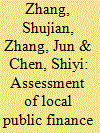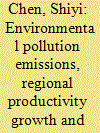| Srl | Item |
| 1 |
ID:
116483


|
|
|
|
|
| Publication |
2012.
|
| Summary/Abstract |
Making use of the data envelopment analysis (DEA) technique and taking undesirable fiscal phenomena into account, this paper comprehensively quantifies the public finance performance of local governments in China during the course of fiscal decentralization reform. The introduction of undesirable fiscal outcomes into this assessment makes it possible to identify meaningful and informative characteristics of local public finance performance in China. When reforms are first implemented, local public financial performance improves because undesirable fiscal phenomena have not yet become too serious. The tax sharing system reform did not work well in its early stages, and negatively impacted public expenditure efficiency. The reform started to play a substantial role between 2001 and 2005, when local governments experienced better public finance performance. Corresponding to the deterioration of the financial sector in recent years, local public financial performance worsened after 2007. Further reform of the current fiscal and taxation system is necessary in China, to ensure a brighter future for the nation.
|
|
|
|
|
|
|
|
|
|
|
|
|
|
|
|
| 2 |
ID:
121339


|
|
|
|
|
| Publication |
2013.
|
| Summary/Abstract |
This paper investigates the impact of energy on China's industrial sustainability by using a novel approach to estimate real total factor productivity. The growth accounting indicates that the substantial industrial reforms in China have led to productivity growth. Energy and capital are also important factors driving China's industrial growth. Productivity growth in China's industry is mostly attributable to the high-tech light industrial sectors.
|
|
|
|
|
|
|
|
|
|
|
|
|
|
|
|
| 3 |
ID:
143397


|
|
|
|
|
| Summary/Abstract |
Environmental pollution emissions have become an extremely serious problem in China that makes its rapid economic growth unsustainable. This paper estimates the energy and emission adjusted total factor productivity (TFP) and reveals the ecological economic transition by province in the light of their contributions to output. The results indicate that China's ecological development fluctuated before 1992, then turned to improve, and peaked between 1999 and 2002. Due to the reappearance of heavy industrialization, China's ecological development process has reversed course since the beginning of this century.
|
|
|
|
|
|
|
|
|
|
|
|
|
|
|
|
| 4 |
ID:
103915


|
|
|
|
|
| Publication |
2011.
|
| Summary/Abstract |
China's industry has experienced robust growth under persistent structural reform since 1978. By estimating the stochastic frontier sectoral production function, we find that the TFP growth has exceeded the quantitative growth of inputs since 1992, but the contribution of productivity to output growth declines after 2001. Using a decomposition technique, we then find that the structural change has contributed to TFP and output growth substantially but also decreasingly over time. Empirical analysis reveals that the reforms in factor markets and industrial structure significantly account for the overall trend and the sectoral heterogeneity of factor allocative efficiency during the industrial transformation process.
|
|
|
|
|
|
|
|
|
|
|
|
|
|
|
|